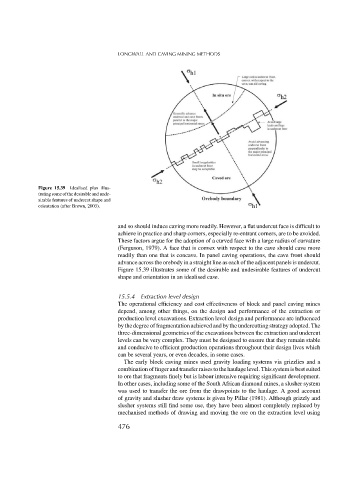Page 494 - Rock Mechanics For Underground Mining
P. 494
LONGWALL AND CAVING MINING METHODS
Figure 15.39 Idealised plan illus-
tratingsomeofthedesirableandunde-
sirable features of undercut shape and
orientation (after Brown, 2003).
and so should induce caving more readily. However, a flat undercut face is difficult to
achieve in practice and sharp corners, especially re-entrant corners, are to be avoided.
These factors argue for the adoption of a curved face with a large radius of curvature
(Ferguson, 1979). A face that is convex with respect to the cave should cave more
readily than one that is concave. In panel caving operations, the cave front should
advance across the orebody in a straight line as each of the adjacent panels is undercut.
Figure 15.39 illustrates some of the desirable and undesirable features of undercut
shape and orientation in an idealised case.
15.5.4 Extraction level design
The operational efficiency and cost effectiveness of block and panel caving mines
depend, among other things, on the design and performance of the extraction or
production level excavations. Extraction level design and performance are influenced
by the degree of fragmentation achieved and by the undercutting strategy adopted. The
three-dimensional geometries of the excavations between the extraction and undercut
levels can be very complex. They must be designed to ensure that they remain stable
and conducive to efficient production operations throughout their design lives which
can be several years, or even decades, in some cases.
The early block caving mines used gravity loading systems via grizzlies and a
combination of finger and transfer raises to the haulage level. This system is best suited
to ore that fragments finely but is labour intensive requiring significant development.
In other cases, including some of the South African diamond mines, a slusher system
was used to transfer the ore from the drawpoints to the haulage. A good account
of gravity and slusher draw systems is given by Pillar (1981). Although grizzly and
slusher systems still find some use, they have been almost completely replaced by
mechanised methods of drawing and moving the ore on the extraction level using
476

